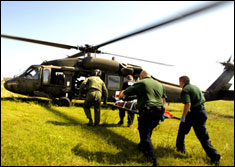Leader's Manual for Combat Stress Control
FM 22-51
|
CHAPTER 1: Overview of Combat Stress Control 1-1. Introduction
1-2. Combat Stress Control b. The art of war aims to impose so much stress on the enemy soldiers that they lose their will to fight. Both sides try to do this and at times accept severe stress themselves in order to inflict greater stress on the enemy. To win, combat stress must be controlled. c. The word control has been chosen deliberately to focus thinking and action within the Army. Since the same word may have contrasting connotations to different people, it is important to make its intended meaning clear. The word control is used (rather than the word management) to emphasize the active steps which leaders, supporting personnel, and individual soldiers must take to keep stress within the acceptable range. This does not mean that control and management are mutually exclusive terms. Management is, by definition, the exercise of control. Within common usage, however, and especially within Army usage, management has the connotation of being a somewhat detached, number-driven, higher echelon process rather than a direct, inspirational, leadership process. d. Stress is the body's and mind's process for dealing with uncertain change and danger. Elimination of stress is both impossible and undesirable in either the Army's combat or peacetime missions. e. The objectives of stress control are as follows:
f. How can stress be controlled? Stress is controlled in the same ways other complex processes are controlled.
|
TABLE OF CONTENTS PREFACE Chapter 1: Overview of Combat Stress Control Chapter 2: Stress and Combat Performance Chapter 3: Positive Combat Stress Behaviors Chapter 4: Combat Misconduct Stress Behaviors Chapter 5: Battle Fatigue Chapter 6: Post-Traumatic Stress Disorder Chapter 7: Stress Issues in Army Operations Chapter 8: Stress and Stressors Associated with Offensive/Defensive Operations Chapter 9: Combat Stress Control in Operations Other than War Chapter 10: War and the Integrated (Nuclear, Biological, and Chemical) Battlefield Chapter 11: Prevention of Battle Fatigue Casualties and Misconduct Stress Behaviors Appendix A: Leader Actions to Offset Battle Fatigue Risk Factors Appendix B: Organization and Functions of Army Medical Department Combat Stress Control Units Appendix C: United States Army Bands Appendix D: The Unit Ministry Team's Role in Combat Stress Control and Battle Fatigue Ministry Appendix E: Example Lesson Plan Glossary Referneces Index |
HEADQUARTERS
DEPARTMENT OF THE ARMY
Washington, DC, 29 September 1994
Home · Textbooks and Manuals · Videos · Lectures · Distance Learning · Training · Operational Safety · Search
This website is dedicated to the development and dissemination of medical information that may be useful to those who practice Operational Medicine. This website is privately-held and not connected to any governmental agency. The views expressed here are those of the authors, and unless otherwise noted, do not necessarily reflect the views of the Brookside Associates, Ltd., any governmental or private organizations. All writings, discussions, and publications on this website are unclassified.
© 2006 Medical Education Division, Brookside Associates, Ltd. All rights reserved
| Field Manual 172 Pages 2.8 MB pdf Download Now |
